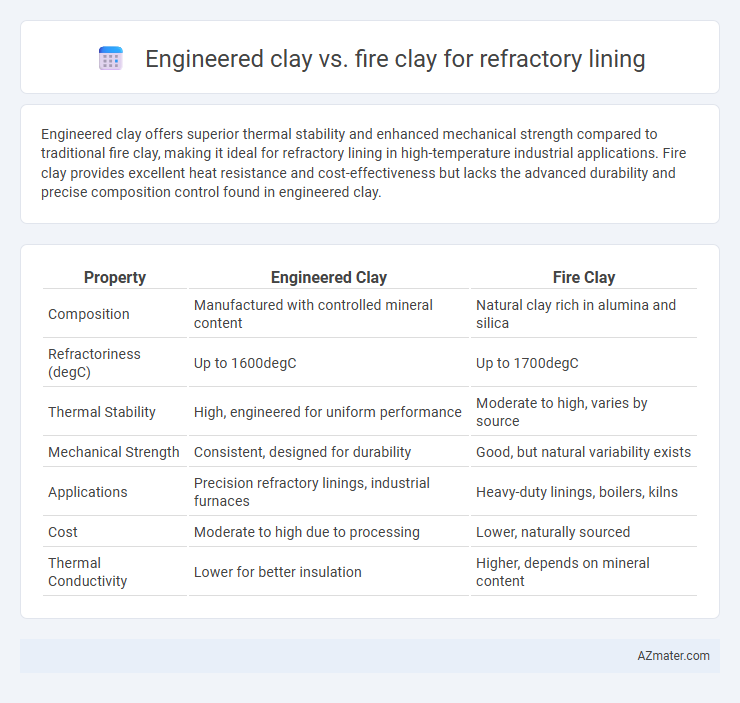Engineered clay offers superior thermal stability and enhanced mechanical strength compared to traditional fire clay, making it ideal for refractory lining in high-temperature industrial applications. Fire clay provides excellent heat resistance and cost-effectiveness but lacks the advanced durability and precise composition control found in engineered clay.
Table of Comparison
| Property | Engineered Clay | Fire Clay |
|---|---|---|
| Composition | Manufactured with controlled mineral content | Natural clay rich in alumina and silica |
| Refractoriness (degC) | Up to 1600degC | Up to 1700degC |
| Thermal Stability | High, engineered for uniform performance | Moderate to high, varies by source |
| Mechanical Strength | Consistent, designed for durability | Good, but natural variability exists |
| Applications | Precision refractory linings, industrial furnaces | Heavy-duty linings, boilers, kilns |
| Cost | Moderate to high due to processing | Lower, naturally sourced |
| Thermal Conductivity | Lower for better insulation | Higher, depends on mineral content |
Introduction to Refractory Lining Materials
Engineered clay and fire clay are critical materials used in refractory linings, essential for withstanding high temperatures in industrial furnaces and kilns. Engineered clay offers enhanced thermal resistance and structural integrity due to controlled composition and processing, whereas fire clay provides natural aluminosilicate content with excellent heat retention but less uniformity. Selecting between engineered clay and fire clay depends on specific thermal requirements, mechanical strength, and chemical stability needed for effective refractory lining performance.
Overview of Engineered Clay and Fire Clay
Engineered clay for refractory lining is specially formulated to offer improved thermal stability, mechanical strength, and resistance to chemical attack compared to natural clays. Fire clay, a naturally occurring material, contains high alumina content and provides excellent heat resistance and refractory properties due to its mineral composition. Engineered clay is often customized for specific industrial applications, whereas fire clay relies on inherent properties, making engineered clay more versatile for advanced refractory linings.
Chemical Composition Comparison
Engineered clay for refractory lining typically contains a controlled mixture of alumina (Al2O3) and silica (SiO2) along with minor oxides, optimized for specific thermal and mechanical properties. Fire clay is naturally occurring, composed mainly of 30-40% alumina and 50-60% silica, with inherent impurities that may affect its performance under extreme heat. The higher alumina content and purity in engineered clay offer enhanced resistance to thermal shock and chemical corrosion compared to traditional fire clay refractory linings.
Thermal Resistance Differences
Engineered clay offers enhanced thermal resistance compared to traditional fire clay due to its tailored composition, which often includes additives that improve high-temperature stability and reduce thermal shock. Fire clay, derived primarily from natural deposits, exhibits good heat resistance but may suffer from lower durability under rapid temperature fluctuations. The superior performance of engineered clay in refractory lining results in longer service life and improved efficiency in high-temperature industrial applications.
Mechanical Strength and Durability
Engineered clay exhibits superior mechanical strength compared to fire clay due to its controlled composition and processing, resulting in enhanced load-bearing capacity for refractory lining applications. Fire clay offers excellent thermal resistance but generally has lower mechanical strength, making it less durable under high-stress conditions. The durability of engineered clay in refractory lining is significantly improved by its uniform microstructure and optimized particle size distribution, which reduces wear and thermal shock damage over time.
Installation Methods and Workability
Engineered clay offers superior workability for refractory lining due to its consistent particle size and formulation, allowing easier mixing and smoother application compared to fire clay. Installation methods with engineered clay often require less moisture control and drying time, enhancing productivity and reducing cracking risks during curing. Fire clay, while more traditional and cost-effective, demands careful water management and longer setting periods to achieve optimal strength and stability in refractory linings.
Performance in High-Temperature Environments
Engineered clay offers superior thermal stability and resistance to chemical corrosion compared to traditional fire clay, making it ideal for high-temperature refractory linings. Fire clay, composed primarily of kaolinite, provides good thermal shock resistance but may degrade faster under extreme temperature fluctuations. The enhanced performance of engineered clay in maintaining structural integrity and minimizing slag penetration ensures longer service life in furnaces and kilns operating above 1600degC.
Cost Analysis: Engineered Clay vs Fire Clay
Engineered clay offers a more consistent chemical composition and enhanced thermal shock resistance, often resulting in lower maintenance costs compared to fire clay in refractory lining applications. Fire clay, while generally less expensive upfront, may incur higher long-term expenses due to variability in raw material quality and increased susceptibility to wear and thermal degradation. Cost analysis typically favors engineered clay for industrial environments where performance durability reduces downtime and replacement frequency.
Application Suitability in Industrial Settings
Engineered clay offers superior chemical stability and thermal resistance, making it ideal for high-temperature industrial applications such as steel manufacturing and glass furnaces. Fire clay, with its natural composition and excellent workability, is suited for moderate temperature environments like boilers, kilns, and fireplaces. Selecting between engineered and fire clay depends on specific temperature ranges, mechanical stress tolerance, and chemical exposure in the refractory lining.
Conclusion: Choosing the Optimal Refractory Lining
Engineered clay offers superior consistency, enhanced thermal shock resistance, and tailored chemical compositions ideal for high-performance refractory lining applications. Fire clay provides cost-effective durability and excellent resistance to heat and abrasion but may lack the precise customization and longevity found in engineered alternatives. Selecting the optimal refractory lining depends on specific operational temperatures, mechanical stress levels, and desired lifespan, with engineered clay being preferable for demanding environments and fire clay suitable for moderate conditions.

Infographic: Engineered clay vs Fire clay for Refractory lining
 azmater.com
azmater.com